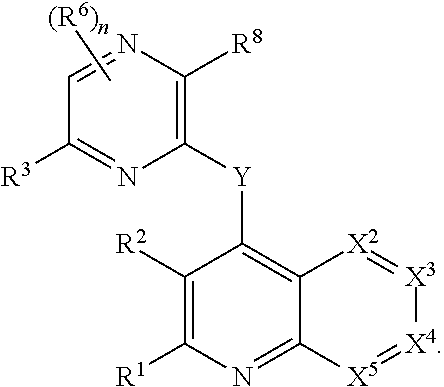Heterocyclic compounds and their uses
a technology of heterocyclic compounds and compounds, applied in the field of heterocyclic compounds and their, can solve the problems of limited utility of these compounds in studying the roles of individual class i pi 3-kinases, compounds, and non-specific pi3k inhibitors
- Summary
- Abstract
- Description
- Claims
- Application Information
AI Technical Summary
Benefits of technology
Problems solved by technology
Method used
Image
Examples
example 1
Preparation of 4-((5,7-difluoro-3-methyl-2-(2-pyridinyl)-4-quinolinyl)amino)-2-(4-morpholinyl)-5-pyrimidinecarboxylic acid
Ethyl 4-hydroxy-2-morpholinopyrimidine-5-carboxylate
[0161]
[0162]A stirred mixture of morpholinoformamidine hydrobromide (3.03 g, 14.4 mmol), diethyl ethoxymethylenemalonate (4.4 mL, 21.8 mmol), and sodium acetate (2.62 g, 31.9 mmol) in DMF (26 mL) was heated to 110° C. After 18 h, the solvent was removed under reduced pressure in a water bath at 65° C. Water was added to the residue then the mixture was warmed to 40° C. After 30 minutes, the solid was filtered then rinsed twice with water. The filter cake was then stirred in diethyl ether at 23° C. After 30 minutes, the white solid was filtered and dried to provide ethyl 4-hydroxy-2-morpholinopyrimidine-5-carboxylate. 1H NMR (400 MHz, DMSO-d6) δ ppm 11.48 (1H, br. s.), 8.44 (1H, s), 4.17 (2H, q, J=7.1 Hz), 3.78 (4H, m), 3.68 (4H, m), 1.24 (3H, t, J=7.1 Hz). Mass Spectrum (ESI) m / e=254.1 (M+H)+.
Ethyl 4-chloro-2-mo...
example 2
Preparation of 4-((5,7-Difluoro-3-methyl-2-(2-pyridinyl)-4-quinolinyl)amino)-2-(4-morpholinyl)-5-pyrimidinecarboxylic Acid
[0171]
[0172]A pre-mixed solution of 2.0M sodium hydroxide (1.0 mL, 2.0 mmol), ethanol (2.0 mL), and THF (2.0 mL) was added to a vial containing ethyl 4-((5,7-difluoro-3-methyl-2-(2-pyridinyl)-4-quinolinyl)amino)-2-(4-morpholinyl)-5-pyrimidine-carboxylate (0.11 g, 0.22 mmol). This solution was stirred at 23° C. and monitored with TLC and LC-MS. After 24 h, the mixture was diluted with water and neutralized with saturated aq. ammonium chloride solution, then extracted five times with EtOAc. The organic phase was dried over anhydrous magnesium sulfate then filtered and concentrated. The residue was treated with MeOH then warmed to 40° C. After 15 minutes, the solvent was removed under reduced pressure to a volume of ˜1 mL. After cooling to rt, the light yellow solid was filtered and identified as 4-((5,7-difluoro-3-methyl-2-(2-pyridinyl)-4-quinolinyl)amino)-2-(4-mor...
example 3
Preparation of N-(3-(4-(5,7-difluoro-3-methyl-2-(pyridin-2-yl)quinolin-4-ylamino)-2-morpholinopyrimidin-5-yl)phenyl)methanesulfonamide
5-Bromo-2-morpholinopyrimidin-4-amine
[0173]
[0174]5-Bromo-2-chloropyrimidin-4-amine (0.62 g, 3.0 mmol) and morpholine (3.0 mL, 34 mmol) were added to a vial and heated to 110° C. After 1 h, the residue was diluted with EtOAc then combined and washed once with 2M sodium carbonate and once with brine. After dying over anhydrous sodium sulfate, filtration and concentration, the light yellow solid was treated with isopropanol and spun in a 45° C. water bath. After 15 min, the solvent was cond to a volume ˜2 mL then filtered. The white solid was washed an additional time with Et2O. The white solid was identified as 5-bromo-2-morpholinopyrimidin-4-amine. 1H NMR (400 MHz, CDCl3) δ ppm 8.01 (1H, s), 5.03 (2H, br. s.), 3.83 (8H, m).
N-(3-(4-Amino-2-morpholinopyrimidin-5-yl)phenyl)methanesulfonamide
[0175]
[0176]5-Bromo-2-morpholinopyrimidin-4-amine (0.13 g, 0.49 m...
PUM
| Property | Measurement | Unit |
|---|---|---|
| pH | aaaaa | aaaaa |
| volume | aaaaa | aaaaa |
| volume | aaaaa | aaaaa |
Abstract
Description
Claims
Application Information
 Login to View More
Login to View More - R&D
- Intellectual Property
- Life Sciences
- Materials
- Tech Scout
- Unparalleled Data Quality
- Higher Quality Content
- 60% Fewer Hallucinations
Browse by: Latest US Patents, China's latest patents, Technical Efficacy Thesaurus, Application Domain, Technology Topic, Popular Technical Reports.
© 2025 PatSnap. All rights reserved.Legal|Privacy policy|Modern Slavery Act Transparency Statement|Sitemap|About US| Contact US: help@patsnap.com



